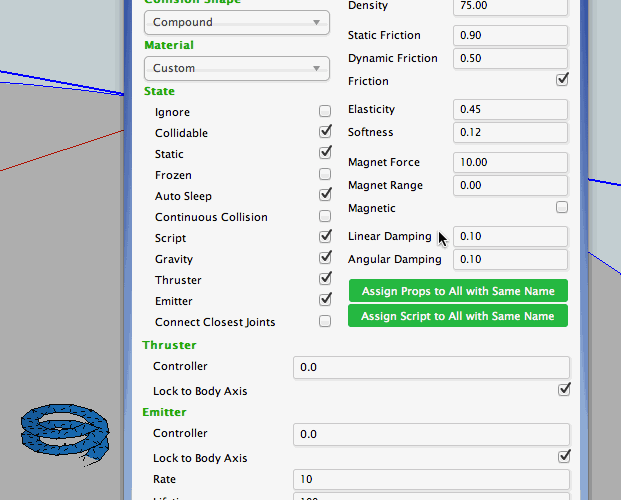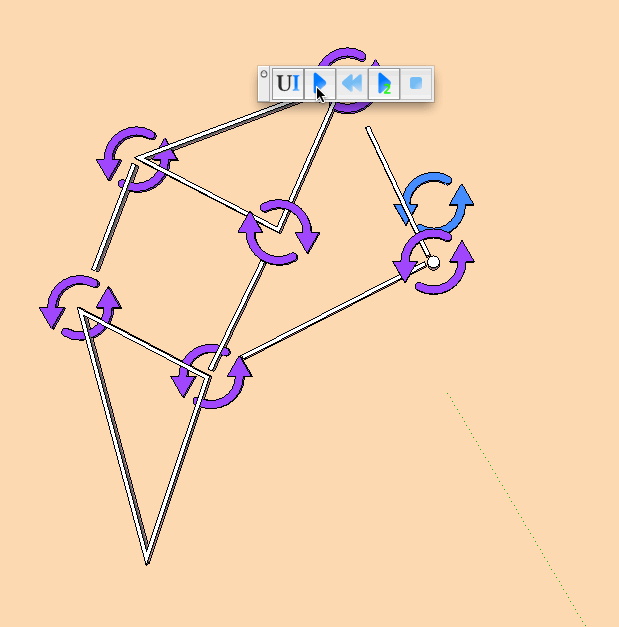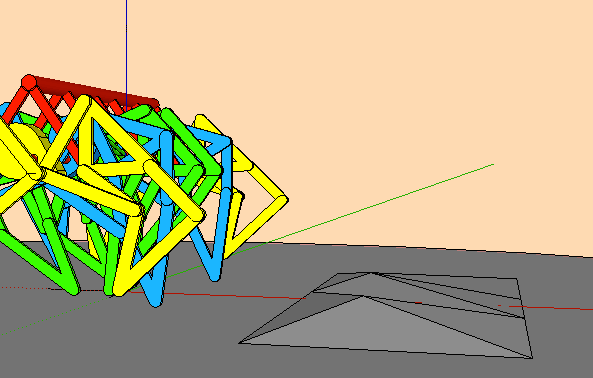MSPhysics 1.0.3 (16 October 2017)
-
Hi, Robin,
The block doesn't sit still probably because you disabled the friction. Enabling the friction checkbox option for the block and for the floor contacting the block will fix the wandering off behavior.
I will add an option to control accel and damp with the SI units in the upcoming release. At the moment, I figured that spring constant is roughly equals to (accel * 7 - damp), when spring joint stiffness is set to 1.0.
Edit: Ensure that both anuglar and linear damping for all bodies are set to zero. This improves the closeness.
Anton
-
Hi Anton
I'm sure I tried every way with the friction coeffs, and it didnt seem to help much, unless Im doing something wrong. If you could get real SI units into the spring damper model this would be fantastic. Classic maths leaves everything in normalised units which is really hard for students to translate into the real world - thats what MS physics is about. I try to encourage my student to abandon th suck-it-and-see approach in favour of understanding what is really happening and calculating the effect. I know that math is a real turn off for most users, but I try
cheers Robin
-
@anton_s said:
Hi, Robin,
The block doesn't sit still probably because you disabled the friction. Enabling the friction checkbox option for the block and for the floor contacting the block will fix the wandering off behavior.
I will add an option to control accel and damp with the SI units in the upcoming release. At the moment, I figured that spring constant is roughly equals to (accel * 7 - damp), when spring joint stiffness is set to 1.0.
Edit: Ensure that both anuglar and linear damping for all bodies are set to zero. This improves the closeness.
Anton
Yes indeed, improved action, I missed the friction box
Herewith a revised model changing block mass from 0 - 0.5 kg gives a displacement of 0 - 1.0 so the spring rate is 2
spring stiff 1 (what does this do?)
Accel 1, damp 1.5 (gives critical damping approx)changing sample rate from 1/60 to 1/240 changes the whole model performance
iterations 16 - improves stability
the plane has a mass of 0.01kg, lowest i could get without instability
So Ive actually got a spring damper that sort of behaves but it seems like the spring has inertial mass - an ideal spring should be zero mass and friction
What do you think? Anything I can do to help (ruby dummy just now)
Cheers
Robin)

-
Hi, Robin,
I just revised the spring joint to base on Hooke's law. Just need to adress a few other things before its ready for the release.
Regards,
Anton -
@anton_s said:
Hi, Robin,
I just revised the spring joint to base on Hooke's law. Just need to adress a few other things before its ready for the release.
Regards,
AntonHi Anton
It occured to me loking at the motor joint, that it would be neat to have control sliders on important coeffs, of spring rate, friction, and damping, help to speed up student experience
BTW just seen some example in Sketchucation, blown away with the talent out there
Hope my little exercises aren' t too dull
Cheers
Robin
-
-
Hi, gilles,
You just need to adjust motor joint properties. So, select the motor joint, open MSPhysics UI, and set Accel to 20, Damp to 10, and uncheck the Free Rotate checkbox option. This should make the motor more stronger.
Anton
-
-
Very clever, gilles!
I'm sure there is a way to improve performance and stiffness of that thing.
Anton
-
Théo Jansen.
-
The peaceful robots!

-
I had issues with MS UI: modifying values, sometimes works sometimes not.

Then I notice this: typing a value +enter or tab does not work.

Typing a value + click outside the input box works…
Just for anybody else having the same troubles.

Mac OSX 10.8.5, SU2015.
-
Yeah, I'm working on that. Thanks for the report, gilles!
-
@gilles said:
I had issues with MS UI: modifying values, sometimes works sometimes not.

Then I notice this: typing a value +enter or tab does not work.

Typing a value + click outside the input box works…
Just for anybody else having the same troubles.
[attachment=0:3sqfwcxi]<!-- ia0 -->MS-UI.gif<!-- ia0 -->[/attachment:3sqfwcxi]
Mac OSX 10.8.5, SU2015.
Hi gilles
I don't know if this is related but i noticed that when trying to alter friction, on cursor in window an X appears on the rhs and a new input will only be accepted after mouse over click X which blanks the window for a new entry
kinda convoluted
Robin
-
Announcing 0.9.9!
This version comes with mainly an improved dialog and joints.
View changelog for details: http://www.rubydoc.info/github/AntonSynytsia/MSPhysics/file/CHANGELOG.md
Anton
-
Thanks Anton for fixing the full-screen issue my animations are back to normal

MSPhysics 0.9.9
tested on win 8.1 and sketchup 2015/2016 working fine.the new plane joint works great on single or two different planes

thx again and merry xmas
Tez
-
Hello, Tez,
Good to hear that it's working now. And merry Christmas to you too!
Best regards,
Anton -
Sorry Anton forgot to ask u in my last post about simple OnTouch sound scripts
in Sketchyphysics i just tick the OnTouch panel and use
playSound('Sound1')what's the MSphysics equivalent script for Ontouch sound .....i keep getting an error?
its no bug ..just me don't understand MS scripts yet.Tez
-
Hi Anton, installed 0.9.9 and restarted SU
but its screwed up my model?
It falls downwards and I cant get the static floor to work as before, also the script stopped working
Did I do a corrupt installation?Should I have deleted 0.9.8 first - you didnt say?
I assumed it would overwrite and update itself
Where to go? delete and start fresh installation or go back to 0.9.8?What to do?

Robin
-
Tez,
In the Sound tab of the MSPhysics UI, whenever a sound is added, a piece of code for playing the sounds is displayed below. For your case, after you add the sound to the MSPhysics UI, the code for playing it would be:
onTouch { |toucher, position, normal, force, speed| simulation.play_sound("Sound1") }You can also refer to this scripting documentation link for playing 3D sounds: http://www.rubydoc.info/github/AntonSynytsia/MSPhysics/master/file/Overview.md#Music___Sound
Anton
Advertisement









